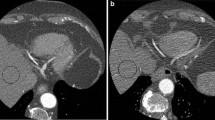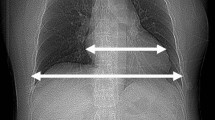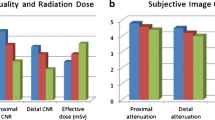Abstract
To individually optimize contrast medium protocol for high-pitch prospective ECG-triggering coronary CT angiography using body weight. Ninety patients undergoing high-pitch coronary CT angiography were randomly assigned to 3 contrast medium injection protocols with bolus tracking technique: Group A, 0.7 ml CM per kg patient weight (ml/kg); Group B, 0.6 ml/kg; Group C, 0.5 ml/kg. Each group had 30 patients. The CT values of superior vena cava (SVC), pulmonary artery (PA), ascending aorta (AA), left atrium (LA), left ventricle (LV), left main artery (LM) and proximal segment of right coronary artery (RCA) were measured. The image quality of coronary artery was evaluated on per-segment basis using a 4-point scale (1-excellent, 4-non-diagnosis). The CT value was not significantly different on AA (p = 0.735), LM (p = 0.764), and proximal segment of RCA (p = 0.991). The CT value was significantly different on SVC, PA, LA and LV (all p < 0.05). The mean image quality score was 1.6 ± 0.1, 1.6 ± 0.1 and 1.6 ± 0.1 (p = 0.217). The volume of CM was 47 ± 8, 44 ± 8 and 36 ± 6 ml for 3 groups (p < 0.001). The effective radiation dose was 0.88 ± 0.04, 0.87 ± 0.06, and 0.85 ± 0.07 mSv for 3 groups. Contrast medium could be reduced to 0.5 ml/kg for high-pitch coronary CT angiography without compromising diagnostic image quality, which associated ~50 % reduction of total contrast volume compared with standard contrast protocol with test bolus technique.

Similar content being viewed by others
References
Nash K, Hafeez A, Hou S (2002) Hospital-acquired renal insufficiency. Am J Kidney Dis 39(5):930–936
Nyman U, Almen T, Aspelin P, Hellstrom M, Kristiansson M, Sterner G (2005) Contrast-medium-induced nephropathy correlated to the ratio between dose in gram iodine and estimated GFR in mL/min. Acta Radiol 46:830–842
Laville M, Juillard L (2010) Contrast-induced acute kidney injury: how should at-risk patients be identified and managed? J Nephrol. Jul-Aug 23(4):387–398
Roberts WT, Bax JJ, Davies LC (2008) Cardiac CT and CT coronary angiography: technology and application. Heart 94(6):781–792
Cademartiri F, Nieman K, van der Lugt A et al (2004) Intravenous contrast material administration at 16-detector row helical CT coronary angiography: test bolus versus bolus-tracking technique. Radiology 233(3):817–823
Rist C, Nikolaou K, Kirchin MA et al (2006) Contrast bolus optimization for cardiac 16-slice computed tomography: comparison of contrast medium formulations containing 300 and 400 milligrams of iodine per milliliter. Invest Radiol 41(5):460–467
Tatsugami F, Kanamoto T, Nakai G et al (2010) Reduction of the total injection volume of contrast material with a short injection duration in 64-detector row CT coronary angiography. Br J Radiol 83(985):35–39
Tatsugami F, Matsuki M, Inada Y et al (2010) Feasibility of low-volume injections of contrast material with a body weight-adapted iodine-dose protocol in 320-detector row coronary CT angiography. Acad Radiol. 17(2):207–211
Miller JM, Dewey M, Vavere AL et al (2009) Coronary CT angiography using 64 detector rows: methods and design of the multi-center trial CORE-64. Eur Radiol 19(4):816–828
Johnson PT, Pannu HK, Fishmen EK (2009) IV contrast infusion for coronary artery CT angiography: literature review and results of a nationwide survey. AJR Am J Roentgenol 192(5):W214–W221
Husmann L, Herzog BA, Burkhard N et al (2009) Body physique and heart rate variability determine the occurrence of stair-step artefacts in 64-slice CT coronary angiography with prospective ECG-triggering. Eur Radiol 19(7):1698–1703
Aldrovandi A, Maffei E, Palumbo A et al (2009) Prognostic value of computed tomography coronary angiography in patients with suspected coronary artery disease: a 24-month follow-up study. Eur Radiol 19(7):1653–1660
Lund GK, Wegian E, Saeed M, Wassermeyer J, Adam G, Stork A (2009) 64-Slice spiral computed tomography of the coronary arteries: dose reduction using an optimized imaging protocol including individual weight adaptation of voltage and current-time product. Eur Radiol 19(5):1132–1138
Leschka S, Stolzman P, Desbiolles L et al (2009) Diagnostic accuracy of high-pitch dual-source CT for the assessment of coronary stenoses: first experience. Eur Radiol 219(3):2896–2903
Wang D, Hu XH, Zhang SZ, Wu RZ, Xie SS, Chen B, Zhang QW (2012) Image quality and dose performance of 80 kV low dose scan protocol in high-pitch spiral coronary CT angiography: feasibility study. Int J Cardiovasc Imaging 28(2):415–423
From AM, Bartholmai BJ, Williams AW, Cha SS, McDonald FS (2008) Mortality associated with nephropathy after radiographic contrast exposure. Mayo Clin Proc 83(10):1095–1100
Toprak O (2007) Conflicting and new risk factors for contrast induced nephropathy. J Urol 178(6):2277–2283
Bartholomew BA, Harjai KJ, Dukkipati S et al (2004) Impact of nephropathy after percutaneous coronary intervention and a method for risk stratification. Am J Cardiol 93(12):1515–1519
Abe M, Kimura T, Morimoto T, Furukawa Y, Kita T (2009) Incidence of and risk factors for contrast-induced nephropathy after cardiac catheterization in Japanese patients. Circ J 73(8):1518–1522
Best PJ, Lennon R, Ting HH et al (2002) The impact of renal insufficiency on clinical outcomes in patients undergoing percutaneous coronary interventions. J Am Coll Cardiol 39(7):1113–1119
Lindsay J, Canos DA, Apple S, Pinnow E, Aggrey GK, Pichard AD (2004) Cause of acute renal dysfunction after percutaneous coronary intervention and comparison of late mortality rates with postprocedure rise of creatine kinase-MB versus rise of serum creation. Am J Cardiol 94(6):786–789
Solomon RJ, Mehran R, Natarajan MK et al (2009) Contrast-induced nephropathy and long-term adverse events: cause and effect? Clin J Am Soc Nephrol. 4(7):1162–1169
Trivedi H, Foley WD (2010) Contrast-induced nephropathy after a second contrast exposure. Ren Fail 32(7):796–801
Hein PA, May J, Rogalla P, Butler C, Hamm B, Lembcke A (2010) Feasibility of contrast material volume reduction in coronary artery imaging using 320-slice volume CT. Eur Radiol 20(6):1337–1343
Kumamaru KK, Steigner ML, Soga S et al (2011) Coronary enhancement for prospective ECG-gated single R–R axial 320-MDCT angiography: comparison of 60- and 80-mL iopamidol 370 injection. AJR Am J Roentgenol 197(4):844–850
Bae KT, Seeck BA, Hildebolt CF et al (2008) Contrast enhancement in cardiovascular MDCT: effect of body weight, height, body surface area, body mass index, and obesity. AJR Am J Roentgenol 190(3):777–784
Nakaura T, Awai K, Yauaga Y et al (2008) Contrast injection protocol computed tomography using a 64-detector scanner: comparison between patient weight-adjusted- and fixed iodine-dose protocols. Invest Radiol 43(7):512–519
Yamamuro M, Tadamura E, Kanao S et al (2007) Coronary angiography by 64-detector row computed tomography using low dose of contrast material with saline chaser: influence of total injection volume on vessel attenuation. J Comput Assist Tomogr 31(2):272–280
Fleischmann D, Kamaya A (2009) Optimal vascular and parenchymal contrast enhancement: the current state of the art. Radiol Clin North Am 47(1):13–26
Yang WJ, Chen KM, Liu B, et al (2012) Contrast media volume optimization in high-pitch dual-source CT coronary angiography: feasibility study. Int J Cardiovasc Imaging [Epub ahead of print]
Conflict of interest
Runze Wu is an employee of Siemens Healthcare.
Author information
Authors and Affiliations
Corresponding author
Rights and permissions
About this article
Cite this article
Liu, J., Gao, J., Wu, R. et al. Optimizing contrast medium injection protocol individually with body weight for high-pitch prospective ECG-triggering coronary CT angiography. Int J Cardiovasc Imaging 29, 1115–1120 (2013). https://doi.org/10.1007/s10554-012-0170-x
Received:
Accepted:
Published:
Issue Date:
DOI: https://doi.org/10.1007/s10554-012-0170-x




